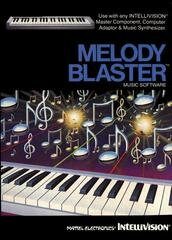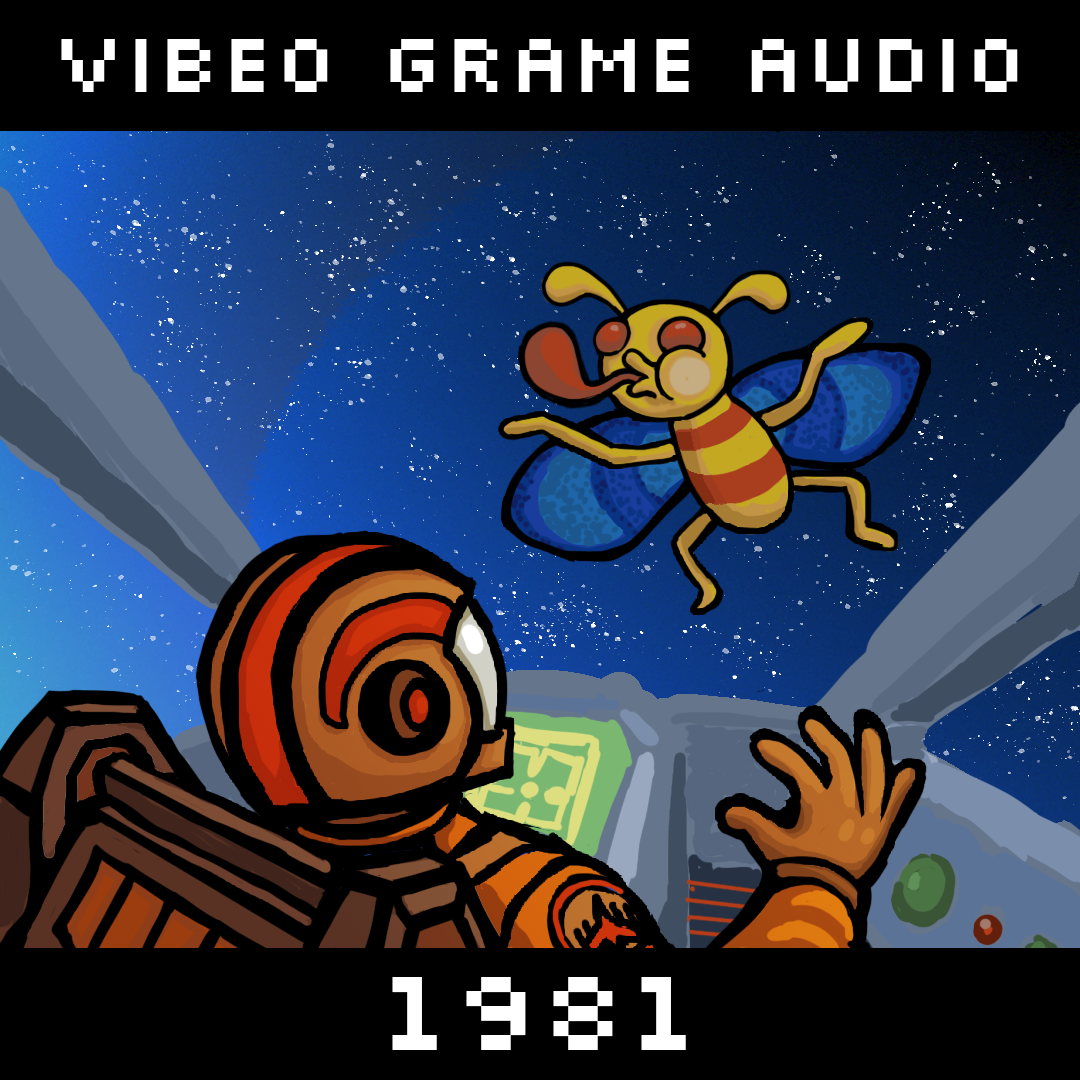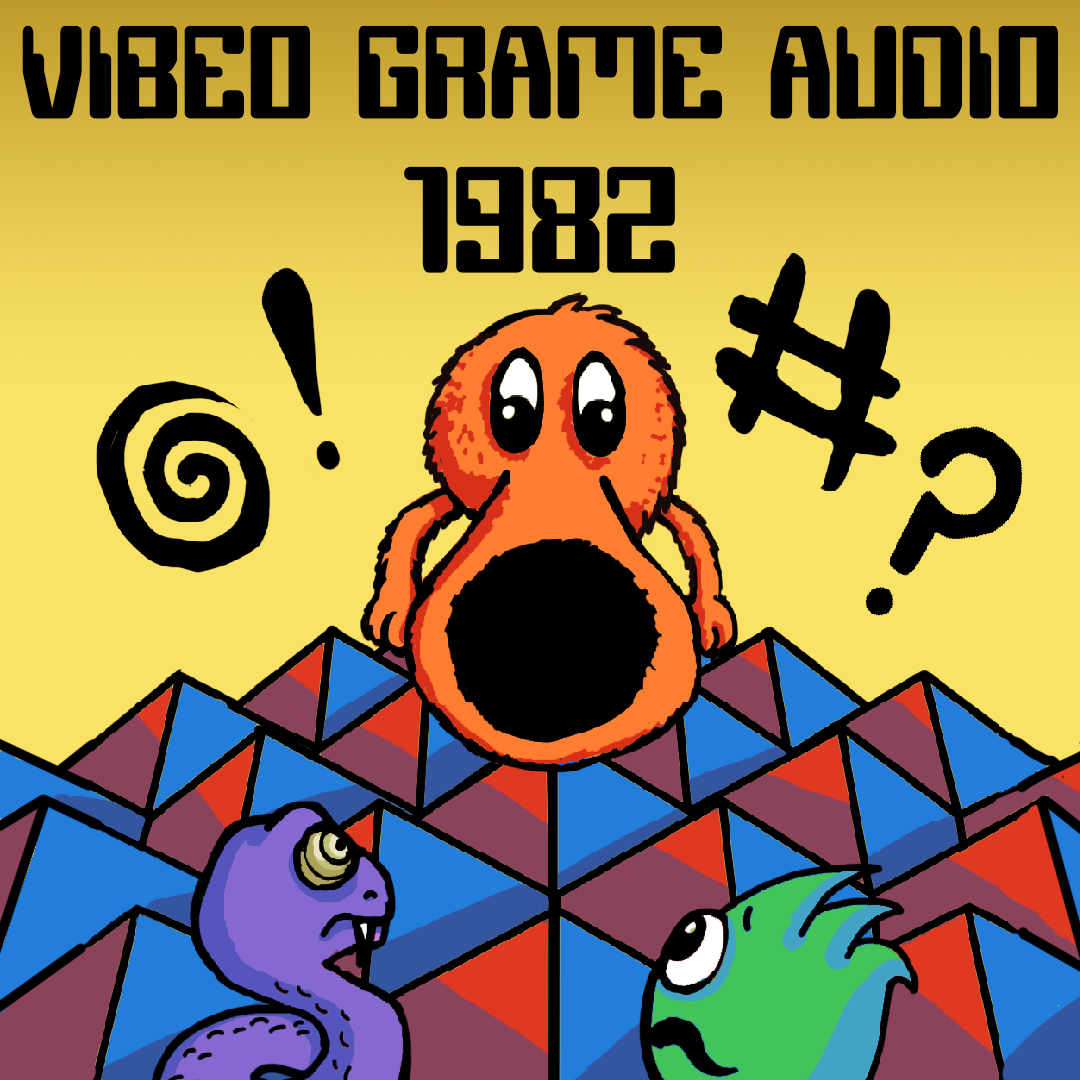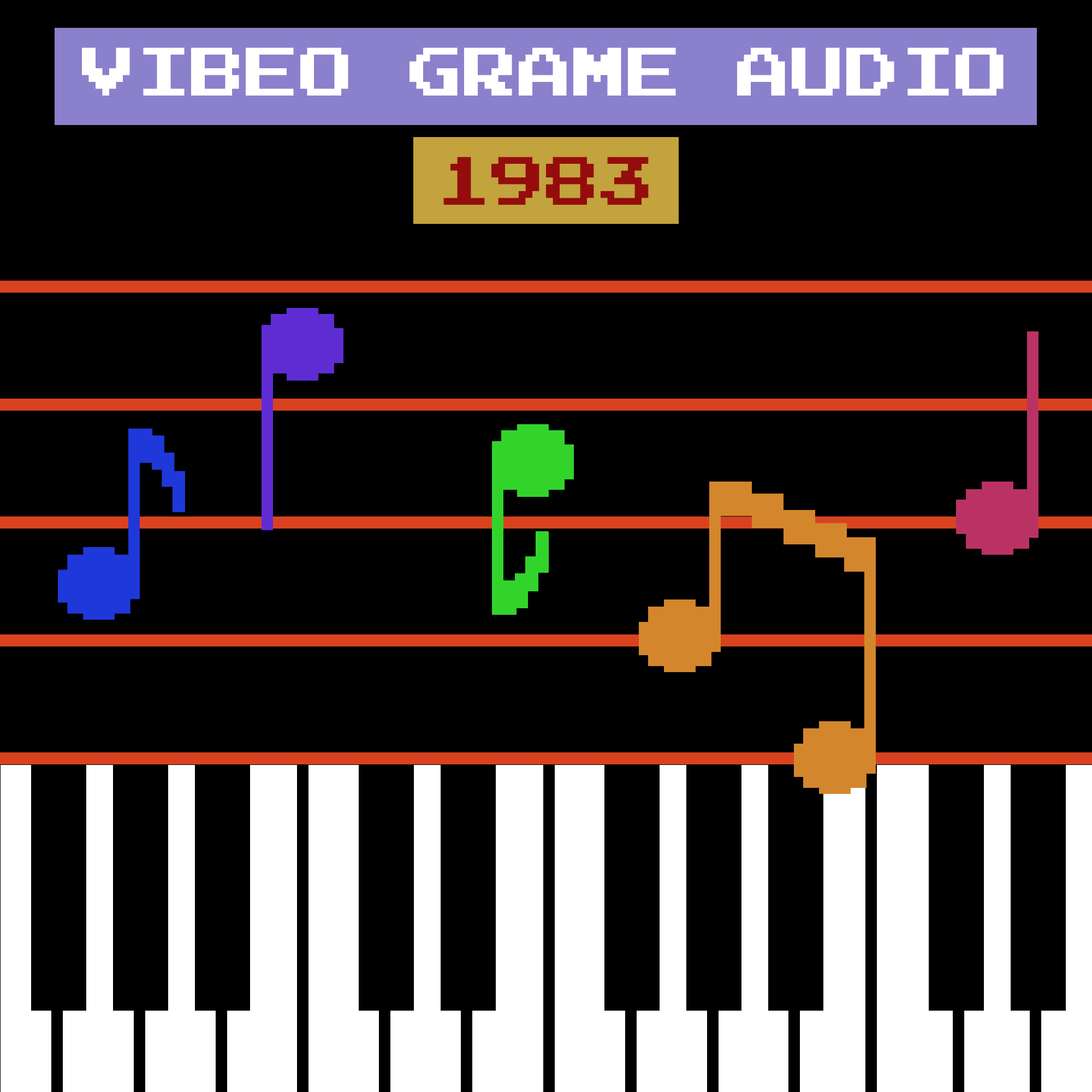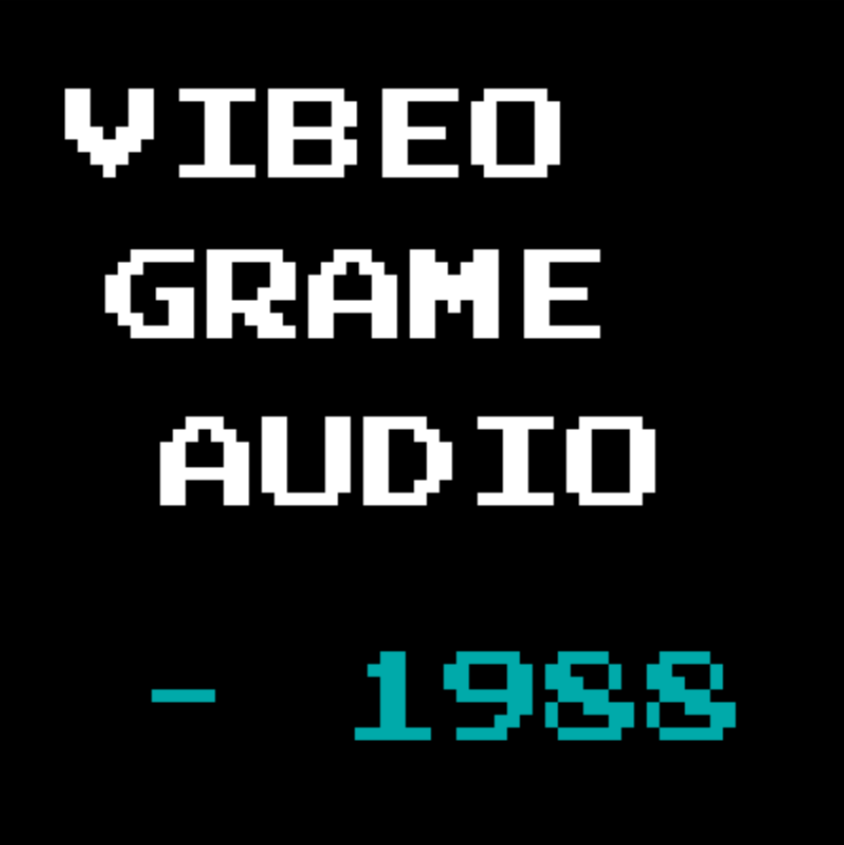Image, as always, by David Matlock (@Empfindsamer)
When I say “1983 was the first year of the 80s” I do have my tongue in my cheek, but only a little. Much of the art from the previous few years feels like the 70s still hadn’t quite worn off. Starting in 1983, gaming took a huge technological leap forward. With the release of the Sega Master System and the Famicom (later released in the U.S. as the Nintendo Entertainment System), the third generation of video game consoles officially began. This is the generation that most of us Millennials think of when we imagine “retro” or “80s” games. The technology of Laserdisc finally got to the arcades, and we saw a few notable titles use it to great effect. In the world of PCs, the Commodore 64 exploded in popularity and became the prime gaming machine.
So games got bigger - a lot bigger. Graphics were good enough now to show sprites (and I mean “sprites” as in “2D rendered objects”) that looked almost like people. More expansive stories with fleshed-out characters meant more music, and specifically music designed with that game’s narrative in mind. So I can almost fill out a whole Top Ten list now! This time I have eight games what are good in my opinion, and one honorable mention I’ve included simply because it was too big to ignore. Enjoy the Top Eight Games of 1983:
“Honorable” Mention
Composer: Chris Stone
Platform: Arcades
On the one hand, it would be criminal to omit this game entirely. It was far and away the most popular Laserdisc game ever made. On the other hand, it’s… not good. The game is ten uninterrupted minutes of quicktime events, an almost universally hated mechanic. Dragon’s Lair wants to be both a movie and a game and doesn’t manage to do either. On top of that, I feel it would be irresponsible to brush past this game without addressing its horrible use of the “damsel in distress” trope.
Old games didn’t have much room for real stories, so the best they could usually do was one or two lines of text that justified your hero going around and doing all the stuff. While there’s a lot of ink to be spilled discussing this trope, I personally don’t fault most devs for falling back on it, usually because the princesses were like four pixels on a screen. But when the princess is a fully realized character in a Don Bluth animation? Animators spent a lot of time on her scantily-clad body. A voice actor had to deliver every line, in an inexplicably infantile and seductive tone. Plenty of screen time is devoted to making sure the player gets a good look at her curves. Suddenly the “damsel in distress” trope isn’t an excuse plot anymore. Watching it now, it’s weird and uncomfortable.
Yeah, yeah, I know, “you’re being too sensitive/it’s just a game/what about Mario/I was born in the 70s and I don’t see a problem with objectifying women” yeah I get it, you’re so cool. Anyway, it’s a shame. Most other games which pioneered new tech led to other games which built upon that tech. Not so with Dragon’s Lair. No one iterated on it. Laserdisc games vanished as quickly as they appeared. Don Bluth stuck to films. The only thing that Dragon’s Lair did that had any cultural impact in the slightest was its misogyny.
This game fucking sucks.
#8: Star Wars
Composer: well, it’s John Williams for the original tunes, but Earl Vickers for the video game arrangement.
Platform: Arcades
This isn’t the first Star Wars game ever made. But it is, far as I’m aware, the first to use extensive sound and music.
All the music is lifted from the Star Wars movies, but the technology wasn’t available to just use clips from the soundtrack. Instead, Vickers had to go through and rearrange the iconic tunes for only four square wave channels. And you know what, they’re pretty incredible arrangements for what limitations are on the system. Technically, there’s no single BGM track in the game - like Frogger, they’re all stingers, but there are so many of them that play so often that it functions like BGM.
As for voice synthesis, this is top notch for the era. The voices are still rather compressed and robotic, but it sounds almost like they got clips of the actors and ran them through a bitcrusher a few times. Nope. Those aren’t voice clips. The voice synthesizer not only managed to produce intelligible speech which didn’t sound too robotic, but produced voices at different registers to sound like different characters.
#7: Pole Position II
Composer: Yuriko Keino, Nobuyuki Ohnogi
Platform: Arcades
Several articles back I mentioned that the best way to follow the development of gaming was to pick a single game and watch how it evolves over time. Pole Position II is not just a sequel to Pole Position - it’s the current peak of the racing game that was started with Gran Trak 10. Look how far the genre has come!
Pole Position II technically didn’t do any one particular thing that hadn’t been done in some other racing game in the past. Each individual sound effect was something at least one other racer implemented. But none of them had used all of them, and not all at once like PPII. This game is noisy. Headphone users, that’s your warning.
#6: M.U.L.E.
Composer: Roy Glover
Platform: PC (Commodore 64)
Oh, I’ve been waiting a long time to get a PC game onto this list. PCs were basically the last of the systems to develop audio for gaming. Home computers, unlike the consoles and arcades, were designed for work first, and most work-related programs didn’t need more than simple beeps, if they needed any audio at all. So nobody really designed computers to play music. Not at first. That all changed in the early 80s.
The Commodore 64 wasn’t the first ever personal computer made with gaming in mind. Years ago Atari had designed their own 8-bit machines, the Atari 400 and 800. Far as I could tell, no one took full advantage of the system’s audio capabilities - not like people did with the Commodore 64. Technically, the C64 hit the market back in 1982, but like most new tech, it took a little while for developers to get a feel for the equipment and make the best use of it. It wasn’t until 1983 when the C64 exploded in popularity and got a ton of new games, plenty of which used the computer’s three audio channels to the fullest extent. M.U.L.E. is the best of those games when it came to audio, featuring a BGM track on a PC game, which was extremely rare then, and automatically grants it spot number 6.
#5: Punch Out
Composer: Koji Kondo
Platform: Arcades
All hail Koji Kondo, the Creator of Heaven and Earth. If there were a pantheon of game composers, Kondo would probably be their leader. There’s a certain quality in a piece of music that makes ordinary people say “that sounds like a video game.” That quality is just what Koji Kondo sounds like. He’s not only the creator of Mario and Zelda music, but the first video game composer who seemed to realize that video game audio could do more than supplement the action in the game. Video game soundtracks could be interesting to listen to on their own.
But back in 1983 he was still just getting started. Nintendo’s “Punch-Out” focused far more on its sound effects and its high-quality voice synthesis than on its music. The soundtrack, if you can call it that, amounted to little more than a bunch of stingers. Even so the style we know Koji Kondo for is already present: the bouncy tempo, catchy hook, quirky accompaniment - all of it lending a childlike innocence and wonder to his music.
#4: Bega’s Battle
Composer: uncredited, possibly Nozomi Aoki, composer for the film of the anime. But I honestly couldn’t tell you.
Platform: Arcades
Dragon’s Lair wasn’t the only game to use the flash-in-the-pan Laserdisc format. I rag on Laserdisc a bit for being a complete dud in the gaming world, but perhaps it was just ahead of its time. It was capable of very impressive visuals and above-average sound, but that was about it. The technology was more advanced than our ability to wield it. Often these were mind-numbingly simple games superimposed on clips from a children’s cartoon. Bega’s Battle suffers from this. The gameplay is ok. I guess you had to be there. But the sound? Unbelievably good.
This is one of the first cases of “Ambient” music in games. Ambient game music is designed primarily to build space, rather than create a melody. It is similar to BGM in that both types of music often loop during gameplay and are used for mood. But where BGM tells a player how to feel about the current game state, ambient music tells them what to feel, replicating the natural sounds of the simulated environment. BGM is the orchestra, while ambience is the sound of the people shuffling in their seats.
#3: Cube Quest
Composer: David Kipping, New Age Sound Labs
Platform: Arcades
I wanted to crack a joke about how it’s hard work to write a unique entry for all these games so I was going to skip Cube Quest. But that’s not why I won’t have much to say about this game. I literally don’t know enough about it. If you played this in 1983, congrats, king.
Cube Quest appeared suddenly in arcades in 1983 and disappeared just as quickly, the debut and only game from the studio Simutrek, and the only credit for David Kipping. Reviews weren’t kind to it, and it vanished mysteriously.
Overall I give it a slight edge over Bega’s Battle. Both are Laserdisc games which are actually good and both feature perhaps the first uses of ambient music. The omnipresent but barely noticeable hum during the stages mixes with the soft sounds of your gun firing, and the weird noises from the even weirder background images... this game genuinely creeps me out. A+. Gold Star.
#2: Ultima III: Exodus
Composer: Ken Arnold
Platform: PC (Apple II)
I’ve been waiting to put Ultima games on this list, but the first two entries had no music, and their sound effects were, shall we say, an assault on the ears. Ultima III: Exodus is the first in the groundbreaking RPG series to use music tracks at all. More than that, it’s the first RPG game for the PC to do so. Even more than that, it’s the first ever game, for any platform, which has a complete soundtrack with multiple musical numbers.
It’s impossible to overstate the impact this series had on gaming as a whole. Though it was not the first RPG series on PC, Ultima ended up defining the genre, not just for the 80s, but forever. The “Western RPG” has its roots here. So what if it took a couple games for the audio to catch up? When we finally got a soundtrack in 1983, it was far and away the most impressive audio accomplishment of the whole year (except for the next game on this list). Never before had a game featured multiple tracks this large, for so many different purposes.
On top of that, the game was designed for the Apple II, which did not have the ability to play the soundtrack at all. In order to listen to the music, you had to get the “Mockingboard,” a peripheral sound chip with three channels. Only the most dedicated gamers got to hear this music in 1983. Luckily for us, someone’s put the whole thing on YouTube so we can just hear it there.
I’m going to put two links here for two reasons. First, while watching the gameplay in action gives a great idea of how the sound and music work in the moment, it’s unreasonable to expect you to watch a nine hour video. And second, now that there’s a full soundtrack of multiple tunes, there’s a video of just those tunes you can watch. Bone apple tea!
Watch a playthrough of Ultima III: Exodus
Listen to the Ultima III soundtrack
#1: Melody Blaster
Composer: Unknown, but also you, the player
Platform: Console (Intellivision)
Okay, I am slightly biased. I am a musician first, not a gamer or game developer. Games about music will always touch my heart in a special way, and this is my hyperfixation and I decide which obsolete technology was best. Melody Blaster is the best game of 1983. This is now a fact.
Melody Blaster is the first ever video game not just about music in general, but music production. The game required an additional peripheral controller, which was essentially a synthesizer hooked up to the Intellivision. You played the keyboard and music popped out the other side. There was a game mode to play along with a pre-made song, making this a primitive version of Rock Band or Guitar Hero. Or you could just jam and make something yourself.
Unfortunately this game is very hard to find anymore. The Intellivision is already one of the more obscure of the already obscure second generation of video game consoles. Even finding gameplay videos was tricky. I’ll link the best one I could manage.











